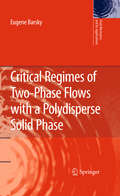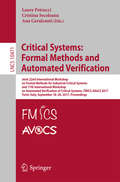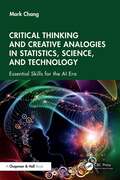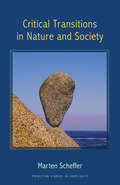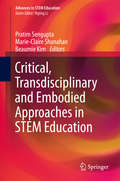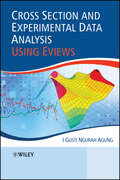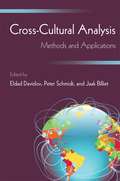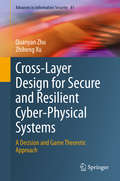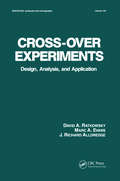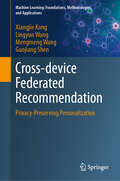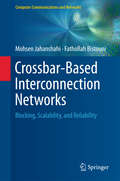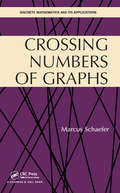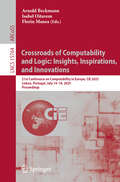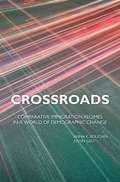- Table View
- List View
Critical Regimes of Two-Phase Flows with a Polydisperse Solid Phase (Fluid Mechanics and Its Applications #93)
by Eugene BarskyCritical regimes of two-phase flows with a polydisperse solid phase form the basis of such widespread industrial processes as separation of various powdery materials and minerals dressing. It is impossible to describe such complicated flows analytically. Therefore, this study concentrates on invariants experimentally revealed and theoretically grounded for such flows. This approach can be compared with the situation in gases, where in order to determine principal parameters of their state, one does not need to measure the kinetic energy and velocity of each molecule and find its contribution to the temperature and pressure. These parameters are determined in a simple way for the system on the whole. A novel conception of two-phase flows allowing the formulation of their statistical parameters is physically substantiated. On the basis of the invariants and these parameters, a comprehensive method of estimating and predicting mass transfer in such flows is developed. It is noteworthy that the presented results are mostly phenomenological. Such an approach can be successfully extended to the separation of liquids, gases and isotopes. The book is intended for students and specialists engaged in chemical technology, mineral dressing, ceramics, microelectronics, pharmacology, power generation, thermal engineering and other fields in which flows carrying solid particles are used in the technological process.
Critical Systems: Joint 22nd International Workshop on Formal Methods for Industrial Critical Systems and 17th International Workshop on Automated Verification of Critical Systems, FMICS-AVoCS 2017, Turin, Italy, September 18–20, 2017, Proceedings (Lecture Notes in Computer Science #10471)
by Laure Petrucci Cristina Seceleanu Ana CavalcantiThis book constitutes the refereed proceedings of the Joint 22nd International Workshop on Formal Methods for Industrial Critical Systems and the 17th International Workshop on Automated Verification of Critical Systems, FMICS-AVoCS 2017, held in Turin, Italy, in September 2017. The 14 full papers presented together with one invited talk were carefully reviewed and selected from 30 submissions. They are organized in the following sections: Automated verification techniques; Testing and scheduling; Formal Methods for mobile and autonomous robots; and Modeling and analysis techniques.
Critical Thinking and Creative Analogies in Statistics, Science, and Technology: Essential Skills for the AI Era
by Mark ChangThrough the lens of critical thinking and creative analogy, this book skillfully blends mainstream perspectives with bold, thought-provoking personal insights, offering readers a fresh and engaging perspective on complex topics. By leveraging critical thinking, creative analogies, and practical examples from statistics, medicine, socioeconomics, education, and technology, it bridges the gap between abstract theory and real-world applications.Each chapter is concise and impactful, cutting straight to the essence of the subject. Thought experiments and vivid examples illuminate key concepts, making them both accessible and actionable. Whether you're seeking clarity, inspiration, or a deeper understanding, this book delivers powerful, thought-provoking content that will leave a lasting impression.Key Features: A harmonious balance of mainstream views and provocative personal insights Creative analogies paired with practical examples from medicine and other fields Concise, clear, and practical chapters that focus on core ideas, enriched with thought experiments and real-world applications A progressive approach, moving from simple daily decision-making to the development of integrated, humanized AI Chapter exercises designed to reinforce concepts through hands-on practice
Critical Transitions in Nature and Society (Princeton Studies in Complexity)
by Marten SchefferHow do we explain the remarkably abrupt changes that sometimes occur in nature and society--and can we predict why and when they happen? This book offers a comprehensive introduction to critical transitions in complex systems--the radical changes that happen at tipping points when thresholds are passed. Marten Scheffer accessibly describes the dynamical systems theory behind critical transitions, covering catastrophe theory, bifurcations, chaos, and more. He gives examples of critical transitions in lakes, oceans, terrestrial ecosystems, climate, evolution, and human societies. And he demonstrates how to deal with these transitions, offering practical guidance on how to predict tipping points, how to prevent "bad" transitions, and how to promote critical transitions that work for us and not against us. Scheffer shows the time is ripe for understanding and managing critical transitions in the vast and complex systems in which we live. This book can also serve as a textbook and includes a detailed appendix with equations.
Critical, Transdisciplinary and Embodied Approaches in STEM Education (Advances in STEM Education)
by Pratim Sengupta Marie-Claire Shanahan Beaumie KimOver the past decade, integrated STEM education research has emerged as an international concern, creating around it an imperative for technological and disciplinary innovation and a global resurgence of interest in teaching and learning to code at the K-16 levels. At the same time, issues of democratization, equity, power and access, including recent decolonizing efforts in public education, are also beginning to be acknowledged as legitimate issues in STEM education. Taking a reflexive approach to the intersection of these concerns, this book presents a collection of papers making new theoretical advances addressing two broad themes: Transdisciplinary Approaches in STEM Education and Bodies, Hegemony and Decolonization in STEM Education. Within each theme, praxis is of central concern including analyses of teaching and learning that re-imagines disciplinary boundaries and domains, the relationship between Art and STEM, and the design of learning technologies, spaces and environments. In addition to graduate research seminars at the Masters and PhD levels in Learning Sciences, Science Education, Educational Technology and STEM education, this book could also serve as a textbook for graduate and pre-service teacher education courses.
Crocheting Adventures with Hyperbolic Planes: Tactile Mathematics, Art and Craft for all to Explore, Second Edition (AK Peters/CRC Recreational Mathematics Series)
by Daina TaiminaWinner, Euler Book Prize, awarded by the Mathematical Association of America. With over 200 full color photographs, this non-traditional, tactile introduction to non-Euclidean geometries also covers early development of geometry and connections between geometry, art, nature, and sciences. For the crafter or would-be crafter, there are detailed instructions for how to crochet various geometric models and how to use them in explorations. New to the 2nd Edition; Daina Taimina discusses her own adventures with the hyperbolic planes as well as the experiences of some of her readers. Includes recent applications of hyperbolic geometry such as medicine, architecture, fashion & quantum computing.
Cross Section and Experimental Data Analysis Using EViews
by I. Gusti AgungA practical guide to selecting and applying the most appropriate model for analysis of cross section data using EViews. "This book is a reflection of the vast experience and knowledge of the author. It is a useful reference for students and practitioners dealing with cross sectional data analysis ... The strength of the book lies in its wealth of material and well structured guidelines ..." Prof. Yohanes Eko Riyanto, Nanyang Technological University, Singapore "This is superb and brilliant. Prof. Agung has skilfully transformed his best experiences into new knowledge ... creating a new way of understanding data analysis." Dr. I Putu Gede Ary Suta, The Ary Suta Center, Jakarta Basic theoretical concepts of statistics as well as sampling methods are often misinterpreted by students and less experienced researchers. This book addresses this issue by providing a hands-on practical guide to conducting data analysis using EViews combined with a variety of illustrative models (and their extensions). Models having numerically dependent variables based on a cross-section data set (such as univariate, multivariate and nonlinear models as well as non-parametric regressions) are concentrated on. It is shown that a wide variety of hypotheses can easily be tested using EViews. Cross Section and Experimental Data Analysis Using EViews: Provides step-by-step directions on how to apply EViews to cross section data analysis - from multivariate analysis and nonlinear models to non-parametric regression Presents a method to test for all possible hypotheses based on each model Proposes a new method for data analysis based on a multifactorial design model Demonstrates that statistical summaries in the form of tabulations are invaluable inputs for strategic decision making Contains 200 examples with special notes and comments based on the author’s own empirical findings as well as over 400 illustrative outputs of regressions from EViews Techniques are illustrated through practical examples from real situations Comes with supplementary material, including work-files containing selected equation and system specifications that have been applied in the book This user-friendly introduction to EViews is ideal for Advanced undergraduate and graduate students taking finance, econometrics, population, or public policy courses, as well as applied policy researchers.
Cross-Cultural Analysis: Methods and Applications
by Eldad Davidov Peter Schmidt Jaak Billiet Bart MeulemanIntended to bridge the gap between the latest methodological developments and cross-cultural research, this interdisciplinary resource presents the latest strategies for analyzing cross-cultural data. Techniques are demonstrated through the use of applications that employ cross national data sets such as the latest European Social Survey. With an emphasis on the generalized latent variable approach, internationally–prominent researchers from a variety of fields explain how the methods work, how to apply them, and how they relate to other methods presented in the book. Syntax and graphical and verbal explanations of the techniques are included. A website features some of the data sets and syntax commands used in the book. Applications from the behavioral and social sciences that use real data-sets demonstrate: The use of samples from 17 countries to validate the resistance to change scale across these nations How to test the cross-national invariance properties of social trust The interplay between social structure, religiosity, values, and social attitudes A comparison of anti-immigrant attitudes and patterns of religious orientations across European countries. The book is divided into techniques for analyzing cross-cultural data within the generalized-latent-variable approach: multiple-group confirmatory factor analysis and multiple-group structural equation modeling; multi-level analysis; latent class analysis; and item-response theory. Since researchers from various disciplines often use different methodological approaches, a consistent framework for describing and applying each method is used so as to cross ‘methodological borders’ between disciplines. Some chapters describe the basic strategy and how it relates to other techniques presented in the book, others apply the techniques and address specific research questions, and a few combine the two. A table in the preface highlights for each chapter: a description of the contents, the statistical methods used, the goal(s) of the analysis, and the data set employed. This book is intended for researchers, practitioners, and advanced students interested in cross-cultural research. Because the applications span a variety of disciplines, the book will appeal to researchers and students in: psychology, political science, sociology, education, marketing and economics, geography, criminology, psychometrics, epidemiology, and public health, as well as those interested in methodology. It is also appropriate for an advanced methods course in cross-cultural analysis.
Cross-Cultural Human-Computer Interaction and User Experience Design: A Semiotic Perspective
by Jan BrejchaThis book describes patterns of language and culture in human-computer interaction (HCI). Through numerous examples, it shows why these patterns matter and how to exploit them to design a better user experience (UX) with computer systems. It provides scientific information on the theoretical and practical areas of the interaction and communication design for research experts and industry practitioners and covers the latest research in semiotics and cultural studies, bringing a set of tools and methods to benefit the process of designing with the cultural background in mind.
Cross-Curricular Teaching and Learning in the Secondary School... Mathematics
by Robert Ward-PennyWhy is cross-curricular work so valuable in the mathematics classroom?Why can pupils sometimes draw graphs in mathematics but not in science?What might mathematics teachers learn from the performing arts?Cross-curricular approaches have much to offer the modern mathematics classroom. They can help teachers to present mathematics as a growing, relevant discipline that is central to much of modern life, and help learners to make sense of what they are doing and why. New contexts, new technology and new qualifications all make this an exciting time to be a cross-curricular teacher of mathematics. But cross-curricular approaches are not always straightforward. Skills do not always transfer easily from one subject area to the other, and a number of important decisions have to be made. How should this type of work be planned, or assessed? How might it fit into the wider curriculum? Are all cross-curricular activities equally useful for learners? Does mathematics have something to share with all of the other curriculum areas?This book tackles these issues head on, combining educational theory and contemporary research with practical ideas and suggestions. From the mathematics of molecular geometry, wind turbines and impact craters to mathematical haikus, Babylonian clay tablets and juggling, each chapter is packed with examples for use in the secondary classroom.Key features include:Discussion of key issues and debatesCase studies to show you how others have used cross-curricular approachesA wide range of examples and practical activities to help you develop your own practiceExample approaches for planning and assessmentPart of the Cross-Curricular Teaching and Learning in the Secondary School series, this book is essential reading for all students on Initial Teacher Training courses and practising teachers looking to holistically introduce cross-curricular themes and practices into their mathematics teaching.
Cross-Layer Design for Secure and Resilient Cyber-Physical Systems: A Decision and Game Theoretic Approach (Advances in Information Security #81)
by Quanyan Zhu Zhiheng XuThis book introduces a cross-layer design to achieve security and resilience for CPSs (Cyber-Physical Systems). The authors interconnect various technical tools and methods to capture the different properties between cyber and physical layers. Part II of this book bridges the gap between cryptography and control-theoretic tools. It develops a bespoke crypto-control framework to address security and resiliency in control and estimation problems where the outsourcing of computations is possible. Part III of this book bridges the gap between game theory and control theory and develops interdependent impact-aware security defense strategies and cyber-aware resilient control strategies.With the rapid development of smart cities, there is a growing need to integrate the physical systems, ranging from large-scale infrastructures to small embedded systems, with networked communications. The integration of the physical and cyber systems forms Cyber-Physical Systems (CPSs), enabling the use of digital information and control technologies to improve the monitoring, operation, and planning of the systems. Despite these advantages, they are vulnerable to cyber-physical attacks, which aim to damage the physical layer through the cyber network.This book also uses case studies from autonomous systems, communication-based train control systems, cyber manufacturing, and robotic systems to illustrate the proposed methodologies. These case studies aim to motivate readers to adopt a cross-layer system perspective toward security and resilience issues of large and complex systems and develop domain-specific solutions to address CPS challenges.A comprehensive suite of solutions to a broad range of technical challenges in secure and resilient control systems are described in this book (many of the findings in this book are useful to anyone working in cybersecurity). Researchers, professors, and advanced-level students working in computer science and engineering will find this book useful as a reference or secondary text. Industry professionals and military workers interested in cybersecurity will also want to purchase this book.
Cross-Over Experiments: Design, Analysis and Application
by David Ratkowsky Richard Alldredge Marc A. EvansDeveloping a model-based approach that enables any cross-over trial, of any degree of imbalance, to be analyzed both for direct effects and for residual effects, using consistent procedures that employ commercially available statistical software, this text offers a guide to the analysis of cross-over designs.;Illustrating practical applications throughout with examples, this book: emphasizes the importance of choosing highly efficient designs that separate treatment and carryover effects; demonstrates the exact methodology needed to handle the analysis of data; presents a new methodology for the analysis of binary and categorical data; and considers the effects of blocking. The appendices facilitate the choosing of an appropriate design for every experimental need.
Cross-device Federated Recommendation: Privacy-Preserving Personalization (Machine Learning: Foundations, Methodologies, and Applications)
by Xiangjie Kong Lingyun Wang Mengmeng Wang Guojiang ShenThis book introduces the prevailing domains of recommender systems and cross-device federated learning, highlighting the latest research progress and prospects regarding cross-device federated recommendation. As a privacy-oriented distributed computing paradigm, cross-device federated learning enables collaborative intelligence across multiple devices while ensuring the security of local data. In this context, ubiquitous recommendation services emerge as a crucial application of device-side AI, making a deep exploration of federated recommendation systems highly significant. This book is self-contained, and each chapter can be comprehended independently. Overall, the book organizes existing efforts in federated recommendation from three different perspectives. The perspective of learning paradigms includes statistical machine learning, deep learning, reinforcement learning, and meta learning, where each has detailed techniques (e.g., different neural building blocks) to present relevant studies. The perspective of privacy computing covers homomorphic encryption, differential privacy, secure multi-party computing, and malicious attacks. More specific encryption and obfuscation techniques, such as randomized response and secret sharing, are involved. The perspective of federated issues discusses communication optimization and fairness perception, which are widely concerned in the cross-device distributed environment. In the end, potential issues and promising directions for future research are identified point by point. This book is especially suitable for researchers working on the application of recommendation algorithms to the privacy-preserving federated scenario. The target audience includes graduate students, academic researchers, and industrial practitioners who specialize in recommender systems, distributed machine learning, information retrieval, information security, or artificial intelligence.
Crossbar-Based Interconnection Networks: Blocking, Scalability, And Reliability (Computer Communications and Networks)
by Mohsen Jahanshahi Fathollah BistouniThis unique text/reference provides an overview of crossbar-based interconnection networks, offering novel perspectives on these important components of high-performance, parallel-processor systems. A particular focus is placed on solutions to the blocking and scalability problems.Topics and features: introduces the fundamental concepts in interconnection networks in multi-processor systems, including issues of blocking, scalability, and crossbar networks; presents a classification of interconnection networks, and provides information on recognizing each of the networks; examines the challenges of blocking and scalability, and analyzes the different solutions that have been proposed; reviews a variety of different approaches to improve fault tolerance in multistage interconnection networks; discusses the scalable crossbar network, which is a non-blocking interconnection network that uses small-sized crossbar switches as switching elements.This invaluable work will be of great benefit to students, researchers and practitioners interested in computer networks, parallel processing and reliability engineering. The text is also essential reading for course modules on interconnection network design and reliability.
Crossing Numbers of Graphs (Discrete Mathematics and Its Applications)
by Marcus SchaeferCrossing Numbers of Graphs is the first book devoted to the crossing number, an increasingly popular object of study with surprising connections. The field has matured into a large body of work, which includes identifiable core results and techniques. The book presents a wide variety of ideas and techniques in topological graph theory, discrete geometry, and computer science. The first part of the text deals with traditional crossing number, crossing number values, crossing lemma, related parameters, computational complexity, and algorithms. The second part includes the rich history of alternative crossing numbers, the rectilinear crossing number, the pair crossing number, and the independent odd crossing number.It also includes applications of the crossing number outside topological graph theory. Aimed at graduate students and professionals in both mathematics and computer science The first book of its kind devoted to the topic Authored by a noted authority in crossing numbers
Crossing the River with Dogs: Problem Solving for College Students
by Judy Kysh Ken Johnson Ted HerrCrossing the River with Dogs: Problem Solving for College Students has been adapted from the popular high school text to provide an accessible and coherent college-level course in mathematical problem solving for adults. Focusing entirely on problem solving and using issues relevant to college students for example, the authors continue their approach of explaining classic as well as non-traditional strategies through dialogs among fictitious students. This text is appropriate for a problem solving, liberal arts mathematics, mathematics for elementary teachers, or developmental mathematics course.
Crossroads of Computability and Logic: 21st Conference on Computability in Europe, CiE 2025, Lisbon, Portugal, July 14–18, 2025, Proceedings (Lecture Notes in Computer Science #15764)
by Florin Manea Arnold Beckmann Isabel OitavemThis book constitutes the refereed proceedings of the 21st Conference on Computability and Logic, CiE 2025, held in Lisbon, Portugal, during July 14–18, 2025. The 27 full papers included in this book were carefully reviewed and selected from 49 submissions. They focus on computability-related science, ranging over mathematics, computer science and applications in various natural and engineering sciences, such as physics and biology, as well as related fields, such as philosophy and history of computing. CiE 2025 hadas its motto Crossroads of Computability and Logic: Insights, Inspirations, and Innovations, drawing on the numerous interconnections between computability research and broader logical methodologies, considering both well-established perspectives as well as recent innovations.
Crossroads: Comparative Immigration Regimes In A World Of Demographic Change
by Anna K. Boucher Justin GestIn this ambitious study, Anna K. Boucher and Justin Gest present a unique analysis of immigration governance across thirty countries. <P><P>Relying on a database of immigration demographics in the world's most important destinations, they present a novel taxonomy and an analysis of what drives different approaches to immigration policy over space and time. In an era defined by inequality, populism, and fears of international terrorism, they find that governments are converging toward a 'Market Model' that seeks immigrants for short-term labor with fewer outlets to citizenship - an approach that resembles the increasingly contingent nature of labor markets worldwide.<P> Introduces a universal empirical conceptualization of an immigration regime.<P> Assembles and analyzes a new cross-national, standardized database of immigration demographic outcomes in thirty countries.<P> Presents a novel, transparently derived taxonomy of immigration regimes worldwide.
Crowd Behavior Simulation of Pedestrians During Evacuation Process: Dem-based Approach (SpringerBriefs in Applied Sciences and Technology)
by Noorhazlinda Abd RahmanThis book introduces the use of the distinct element method (DEM) in modeling crowd behavior and simulating evacuation processes. Focusing on the mathematical computation of the uncertain behavior of evacuees, which is switching action behavior, it subsequently reproduces the crowd evacuation process under several conjectural scenarios using a DEM-based multi-agent model that has been modified by introducing the switching action behavior. The proposed switching action behavior model describes a person who has to change his/her destination due to the limited space capacity of the designated evacuation area. The change in the destination of a person is determined according to the motion of other individuals in the perception domain during the defined switching action time. The switching action time is formulated in the so-called switching action function, which is described by a convolution integral of the input and unit response functions. The newly developed switching action model is then validated using sensitivity analysis in which the primary focus is the crowd motion and flow of switching action behavior.
Crowd Dynamics, Volume 1: Theory, Models, and Safety Problems (Modeling and Simulation in Science, Engineering and Technology)
by Nicola Bellomo Livio GibelliThis volume explores the complex problems that arise in the modeling and simulation of crowd dynamics in order to present the state-of-the-art of this emerging field and contribute to future research activities. Experts in various areas apply their unique perspectives to specific aspects of crowd dynamics, covering the topic from multiple angles. These include a demonstration of how virtual reality may solve dilemmas in collecting empirical data; a detailed study on pedestrian movement in smoke-filled environments; a presentation of one-dimensional conservation laws with point constraints on the flux; a collection of new ideas on the modeling of crowd dynamics at the microscopic scale; and others. Applied mathematicians interested in crowd dynamics, pedestrian movement, traffic flow modeling, urban planning, and other topics will find this volume a valuable resource. Additionally, researchers in social psychology, architecture, and engineering may find this information relevant to their work.
Crowd Dynamics, Volume 2: Theory, Models, and Applications (Modeling and Simulation in Science, Engineering and Technology)
by Livio GibelliThis contributed volume explores innovative research in the modeling, simulation, and control of crowd dynamics. Chapter authors approach the topic from the perspectives of mathematics, physics, engineering, and psychology, providing a comprehensive overview of the work carried out in this challenging interdisciplinary research field. After providing a critical analysis of the current state of the field and an overview of the current research perspectives, chapters focus on three main research areas: pedestrian interactions, crowd control, and multiscale modeling. Specific topics covered in this volume include: crowd dynamics through conservation lawsrecent developments in controlled crowd dynamicsmixed traffic modelinginsights and applications from crowd psychology Crowd Dynamics, Volume 2 is ideal for mathematicians, engineers, physicists, and other researchers working in the rapidly growing field of modeling and simulation of human crowds.
Crowd Dynamics, Volume 3: Modeling and Social Applications in the Time of COVID-19 (Modeling and Simulation in Science, Engineering and Technology)
by Nicola Bellomo Livio GibelliThis contributed volume explores innovative research in the modeling, simulation, and control of crowd dynamics. Chapter authors approach the topic from the perspectives of mathematics, physics, engineering, and psychology, providing a comprehensive overview of the work carried out in this challenging interdisciplinary research field. In light of the recent COVID-19 pandemic, special consideration is given to applications of crowd dynamics to the prevention of the spreading of contagious diseases. Some of the specific topics covered in this volume include: - Impact of physical distancing on the evacuation of crowds- Generalized solutions of opinion dynamics models- Crowd dynamics coupled with models for infectious disease spreading- Optimized strategies for leaders in controlling the dynamics of a crowdCrowd Dynamics, Volume 3 is ideal for mathematicians, engineers, physicists, and other researchers working in the rapidly growing field of modeling and simulation of human crowds.
Crowd Dynamics, Volume 4: Analytics and Human Factors in Crowd Modeling (Modeling and Simulation in Science, Engineering and Technology)
by Nicola Bellomo Livio GibelliThis contributed volume explores innovative research in the modeling, simulation, and control of crowd dynamics. Chapter authors approach the topic from the perspectives of mathematics, physics, engineering, and psychology, providing a comprehensive overview of the work carried out in this challenging interdisciplinary research field. The volume begins with an overview of analytical problems related to crowd modeling. Attention is then given to the importance of considering the social and psychological factors that influence crowd behavior – such as emotions, communication, and decision-making processes – in order to create reliable models. Finally, specific features of crowd behavior are explored, including single-file traffic, passenger movement, modeling multiple groups in crowds, and the interplay between crowd dynamics and the spread of disease.Crowd Dynamics, Volume 4 is ideal for mathematicians, engineers, physicists, and other researchers working in the rapidly growing field of modeling and simulation of human crowds.
Crucial Event Rehabilitation Therapy: Multifractal Medicine (SpringerBriefs in Bioengineering)
by Mauro Bologna Bruce J. West Paolo GrigoliniThis book describes a new strategy for rehabilitation from injury and/or disease using Crucial Event Therapy. Recent studies have shown that individuals can recuperate more rapidly from surgery and other invasive procedures intended to correct the negative effects of disease or injury through the use of life support systems that operate at the body's natural biofrequencies. The same observation has been clinically shown to reverse the degenerative effects of neurodegenerative diseases such as Parkinson’s and Alzheimer's Disease. Crucial Event Therapy describes medicine as the operational control of the functions of the human body treated as a network-of-networks, with 1/f-variable crucial events coding the dynamic states of health and disease through information flow within a network and information exchange between biomedical networks. A new way of thinking based on the statistics of Cortical Events is presented and the relevant literature is suitably referenced. This is an ideal book for biophysicists and data scientists seeking to understand the connection of complexity measures for the study of consciousness with the clinical aspects of designing a rehabilitation strategy.
Cryogenic Safety: A Guide to Best Practice in the Lab and Workplace (International Cryogenics Monograph Series)
by Thomas J. Peterson J. G. Weisend IIThis book describes the current state of the art in cryogenic safety best practice, helping the reader to work with cryogenic systems and materials safely. It brings together information from previous texts, industrial and laboratory safety polices, and recent research papers. Case studies, example problems, and an extensive list of references are included to add to the utility of the text. It describes the unique safety hazards posed by cryogenics in all its guises, including issues associated with the extreme cold of cryogenics, the flammability of some cryogenic fluids, the displacement of oxygen by inert gases boiling off from cryogenic fluids, and the high pressures that can be formed during the volume expansion that occurs when a cryogenic fluid becomes a room temperature gas. A further chapter considers the challenges arising from the behavior of materials at cryogenic temperatures. Many materials are inappropriate for use in cryogenics and can fail, resulting in hazardous conditions. Despite these hazards, work at cryogenic temperatures can be performed safely. The book also discusses broader safety issues such as hazard analysis, establishment of a safe work culture and lessons learned from cryogenic safety in accelerator labs. This book is designed to be useful to everyone affected by cryogenic hazards regardless of their expertise in cryogenics.
